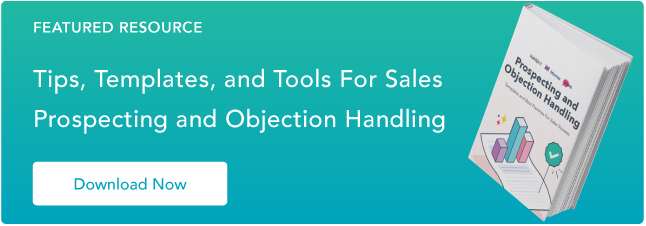1. Research, research, and research some more.
2. Cold call with composure, confidence, and persistence.
3. Maintain a presence in LinkedIn groups.
4. Be active in online forums — relevant to your vertical.
5. Understand your ideal customer profile — inside and out.
6. Understand your buyer personas — inside and out.
8. Capitalize on your inbound marketing.
9. Routinely ask for referrals.
10. Leverage your CRM to inform your efforts.
11. Learn how to communicate with gatekeepers.
What is B2B prospecting?
B2B prospecting is one of the earlier stages in most B2B sales processes. It's a key component of any sale — one where salespeople identify, connect with, and ideally appeal to a potential buyer to set a deal in motion.
B2B prospecting — as with any kind of prospecting — is one of the trickier activities virtually every B2B rep has to conduct at some point in their career. It often involves extensive outreach, thorough research, plenty of rejection, and potential frustration and burnout.
That said, efficient, effective B2B prospecting sustains successful sales processes and keeps sales orgs afloat — so having a sense of how to do it effectively is in every salesperson's best interest.
To help you get there, we've put together a list of some key B2B prospecting methods you can incorporate into your repertoire.
1. Research, research, and research some more.
The most effective prospecting efforts are thoroughly informed and thoughtfully tailored — they resonate with prospects by making them feel like they're more than another name on a list.
The potential customers you connect with will only buy from your company if they believe your solution is the best fit for their business — you could go so far as to say that B2B sales is the art of bridging that gap.
But how can you prove to your prospect that your specific product is the one for their specific business? Well, it all starts with understanding where they're coming from — meaning having a pulse on the company's needs, interests, constraints, and qualities. A significant portion of that insight comes with thorough research.
Scour the web for any public-facing resources about a company. Check the "About Us" page on its website. If it has a blog, get an idea of the content it posts — and be mindful of elements like the tone it's written in. If you can find relevant financial information about how the company is performing, look that over.
One way or another, try to accrue enough information to give you a solid picture of factors like what the business does, how it presents itself, its mission, its leadership, how it's performing — both individually and in the context of its competitive landscape — and where it's ultimately trying to go.
When you have that insight behind you, you'll be in a much better position to have thoughtful, productive B2B prospecting conversations.

2. Cold call with composure, confidence, and persistence.
Cold calling is one of the most frustrating, tedious, demoralizing activities several sales reps have to routinely engage in — LinkedIn even found that 63% of sellers say cold calling is the worst part of their job.
It's a low-converting, nerve-wracking process that forces you to stomach rejection after rejection after rejection. But for all of its flaws, cold calling is still one of the most effective B2B prospecting methods sales orgs can leverage.
So if you want your prospecting efforts to be as productive as possible, you need to have a sense of how to cold call with poise and persistence. Study up on how to tailor your messaging to accommodate cold leads.
That means taking strides like:
- Doing your research ahead of a call
- Understanding how to reference a cold call script without reciting it
- Strategically timing your calls to catch prospects at times when they'll be more receptive to your outreach
- Starting your calls with a proactive reason for the conversation
- Prioritize educating your buyer
Even with those elements down, you should still be prepared to handle your share of hard "no's". You need to truck through all of that rejection as it comes — if you can stick it out, you'll put yourself in the best position possible to prospect effectively.

3. Maintain a presence in LinkedIn groups.
LinkedIn groups relevant to your vertical offer you unique opportunities to productively connect with prospects. If you stay active in these forums — answering members' questions, offering expertise, sending helpful content, and finding other avenues to provide users value — you can source a steady stream of prospects.
This method also lends itself to relationship-building ahead of your outreach. It lets you give a more personal appeal to group members and establish yourself as an authority in your space.
Successful B2B prospecting is, in large part, the practice of establishing trust on a dime — convincing prospects that your solution is worth their legitimate consideration. If you take the time to build a reputation in industry-relevant LinkedIn groups, you can expedite that process.
4. Be active in online forums — relevant to your vertical.
This point is similar to the one above. If you can find industry-specific online forums that serve your vertical, you should consider maintaining an active presence on them. Sites like Reddit often have accessible communities — dedicated to individual industries' trends, common issues, and other topics of discussion.
If you want access to a base of active, engaged, vocal prospects who work at businesses that fit your ideal customer profile, seek out these kinds of online destinations — but if you're interested in pursuing this lane, be sure to study up.
These communities are populated with legitimate enthusiasts — people so invested in their work that they're willing to discuss it on their own time. They're going to be less receptive to overtly sales-y appeals and phoned-in insight.
As I mentioned in the previous point, you need to contribute value to these discussions, so make sure you have the detailed knowledge required to convey it — both technically and in more accessible terms.
5. Understand your ideal customer profile inside and out.
Your ideal customer profile represents the type of business you're most interested in selling to. It's the archetype of a company with the needs, interests, budget, market position, and scale — among other factors — required to be interested in a solution like yours.
If you want to conduct effective B2B prospecting efforts, you need to have a thorough sense of what that business looks like. In many cases, you'll be assigned a specific vertical — generally in the form of a target industry. If you have one, do what you can to understand that space as comprehensively as possible.
What are the issues the businesses that compose it run into most often? What kinds of resources are companies in the space starting to invest in? Are there any trends that a solution like yours could help a customer capitalize on?
Understand how businesses of a certain scale can leverage a product or service like yours. Have a feel for the price points your ideal customers will be able to accommodate. Know the state of a prospect's competitive landscape and where their company fits into it.
If you can go into your prospecting conversations with a sense of those elements, you'll be able to approach the interactions with more tact and confidence.
6. Understand your buyer personas — inside and out.
Once you understand your ideal customer profile as thoroughly as possible, you need to narrow your focus a bit more — lock in your buyer personas. Where an ideal customer profile represents a company you're targeting, a buyer persona is the model of the specific contact you're trying to connect with when prospecting.
For instance, if you sell a conversation intelligence platform and your ideal customer profile is scaling edtech startups, your buyer persona might be a director of business development at one of those companies.
In the same way you need to thoroughly understand what your ideal customer profile needs, you have to get a pulse on what these target contacts will be receptive to — whether that be specific benefits, certain kinds of messaging, or any other elements you can think of to make targeted, effective appeals.
All of that starts with thorough research and is refined through trial and error. Keep detailed notes on how your interactions with these potential customers go when prospecting. There will likely be some growing pains as you familiarize yourself with their needs and interests, but if you pay careful attention and keep at it, you'll be able to consistently conduct effective B2B prospecting efforts with these target contacts.
7. Personalize your outreach.
Cold outreach doesn't have to be freezing. A cookie-cutter prospecting email addressed to "whom it may concern" or "sir or madam" is far more likely to fall by the wayside than one with some degree of personalization.
Always include the prospect's full name when reaching out via email — an activity that several email automation software support. Beyond that, try to make some kind of personal appeal to your prospect in the body of your email.
That could be through actions like referencing a mutual connection, congratulating them for an award their company might have received, commending them for a successful round of funding, complimenting a piece of content they published, or sending them content related to a resource they downloaded.
No one wants to feel like another name on a list, and if your outreach is rigid and impersonal, that's exactly what you're doing to your prospect. You don't have to go too deep — there's no need to ask them how their kid's softball team is doing this season or whether their husband is still thinking about going to law school — but you can't go too shallow either.
.jpg?width=1545&name=REAL%20CONTAINER%20(1).jpg)
8. Capitalize on your inbound marketing efforts.
The leads your company generates through inbound marketing can provide the basis for extremely productive B2B prospecting. The potential customers you connect with via your content have a demonstrated interest in your space and some degree of awareness of your business.
Those factors make those leads warmer than most — they also give you some perspective on a prospect's interests and conversation starters they might be receptive to.
For instance, if you sell a social media management platform and a director-level marketer at a startup downloads your company's ebook about how to promote blog content on LinkedIn, you can send them a prospecting email that links to content about other LinkedIn marketing strategies or snackable blog content that lends itself to social posts.
Inbound marketing gives you some immediate advantages when prospecting. You know the leads you're reaching out to have heard of your company. You know they have some interest in what you do.
And in most cases, a prospect you reach out to has provided some contact and professional information to engage with your content — so you know where they work and their place in their organization.
All of that makes for better-targeted, more effective B2B prospecting.
9. Routinely ask for referrals.
According to HubSpot's recent survey of over 1,000 sales professionals, 66% of salespeople say referrals from existing customers offer the best leads — and high-quality leads tend to translate to easier, more productive B2B prospecting.
Prospects trust other prospects more than salespeople pushing products on them. The familiarity, understanding, and lack of agenda behind customer referrals make the leads they produce more open and intrigued than most others.
But referrals rarely come arbitrarily — you need to give a customer some reason to recommend your solution to their friends, colleagues, or industry peers. That generally starts with offering an exceptional product and supporting it with first-rate customer service.
But even then, a customer might not be motivated or inclined to provide you with new contacts without a little push — that's why you need to connect with your satisfied customers and ask for referrals.
You don't have to inundate a customer with emails and calls — desperately begging them to tell you about peers that could benefit from your product or service. Just include some friendly requests and reminders when you check in with them to see how they're liking your solution.
If you can generate a steady stream of referrals from satisfied customers, you can cultivate a base of leads that will make your B2B prospecting simpler, less imposing, and ultimately more productive.
10. Leverage your CRM to inform your efforts.
As I touched on towards the beginning of this article, understanding your ideal customer profile is central to conducting consistently successful B2B prospecting efforts. But that kind of "understanding" doesn't come out of nowhere — it needs to be well-informed and backed by data.
That's where your CRM comes in. It provides a repository where you can gather your customer data — a centralized location where you can pull the necessary customer data to structure a robust, accurate ideal customer profile.
The insight from your CRM helps you with several key aspects of your B2B prospecting efforts — including your sales messaging, your preferred outreach methods, your outreach cadence, and how to approach recurring objections.
If your org leverages a CRM, make sure you actively contribute the data you accrue from your interactions and reference the existing insight it produces. These kinds of systems can enhance almost every aspect of your org's sales process — and prospecting is no exception. Don't let it go to waste.
11. Learn how to communicate with gatekeepers.
As almost anyone who's conducted B2B prospecting will tell you, there's no guarantee a sales call will automatically connect with a decision-maker. In many cases, you have to work past an intermediary known as a gatekeeper — a company representative that essentially intercepts your call before it can be passed on to the higher-up you're after.
Gatekeepers can include employees like receptionists, executive assistants, or office managers — and understanding how to communicate with them can be the difference between a successful prospecting call and a dial tone.
There are a few ways to handle these representatives — most of which revolve around three factors: familiarity, confidence, and cooperation. If you want to effectively deal with gatekeepers, you need to:
- Come off as unimposing and familiar — act like you're supposed to connect with their boss. Try strategies like name-dropping a mutual connection, doing some research on the gatekeeper specifically, or referring to the decision-maker by their first name.
- Project confidence — again, you want to seem like you're supposed to connect with their boss. Be self-assured without sacrificing politeness when talking with a gatekeeper. Be respectful, but don't be too reserved.
- Work with a gatekeeper as opposed to working through them. Don't be overly pushy, rude, or arrogant — and don't try to sell to them on your call. Ask them how they're doing, and see if you can develop some quick rapport. Cooperate with them, and treat them as resources as opposed to obstacles.
By leveraging these strategies — among others — you'll be able to more thoughtfully deal with gatekeepers and routinely connect with the decision-makers behind them.
As I said, B2B prospecting often involves extensive outreach, thorough research, plenty of rejection, and potential for frustration and burnout — but while the process might be imposing, it doesn't have to be unapproachable. If you use the methods detailed here, you'll set yourself up for success when conducting your efforts.
Sales Prospecting

.jpg)

.webp)






![How to Find Almost Anyone’s Email Address, Without Being Creepy [+Expert Tips]](https://53.fs1.hubspotusercontent-na1.net/hubfs/53/132_Find%20Email%20Address.jpg)

